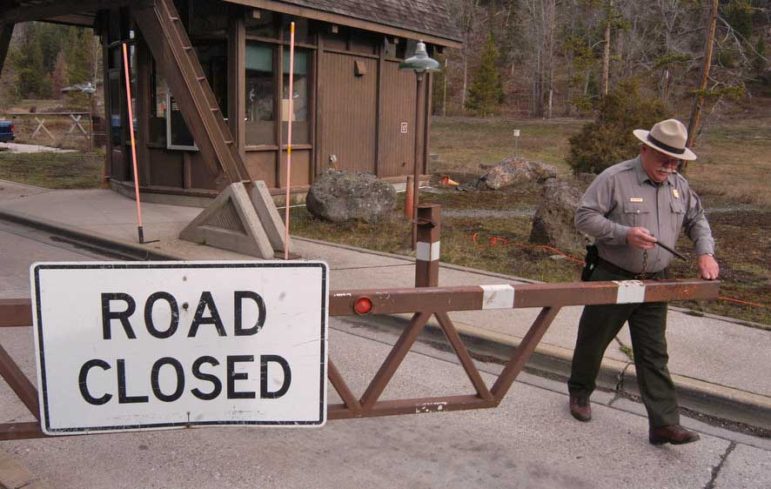
Dennis Lenzendorf opens the Yellowstone East Gate for the first day of the 2012 summer season. (File photo/Ruffin Prevost)
By Ruffin Prevost
CODY, WYO. — Two of the country’s busiest national parks are expecting to reopen to visitors at some point this year, but details are still far from final on when that will happen, or how that process will unfold.
On a conference call lasting nearly two hours Monday with Wyoming civic and business leaders in Cody and Jackson, Yellowstone National Park Superintendent Cam Sholly and Grand Teton National Park Acting Superintendent Gopaul Noojibail stressed a cautious approach to reopening their respective parks.
They were joined on the call by Wyoming Gov. Mark Gordon, and billed the discussion as a listening session, saying it would take time to develop a plan for reopening the parks. A similar call is planned this week for participants in Montana.
Both parks have been closed to help slow the spread of the COVID-19 virus. Gates would normally be opening for the summer season over a traditional period in late April and early May, but managers are looking for local guidance while they develop plans.
Sholly cited the complex web of jurisdictions that Yellowstone Park covers, including governors and county health officials in Wyoming, Montana and Idaho who all have a stake in how park visitation may affect tourism industries and health care systems in remote, rural areas.
“When are you ready to begin having an influx of transient visitors from around the country, and potentially around the world, coming to your communities?” Sholly asked.
Managing spikes in viral outbreaks in small communities “becomes more complicated when you you are talking about 20,000 to 40,000 people per day being in Yellowstone and Grand Teton National Park,” he said.
Sholly said no decision has been made or recommendation has been drafted on how and when to reopen the parks, and that he and Noojibail are hoping for “consistent guidance” from local leaders and health officials across the region on how they want that process to play out.
Meanwhile, crews are continuing to plow roads and prepare for opening, although both parks have cut back on hiring seasonal employees. Managers are focusing right now primarily on staffing for essential facilities like medical clinics, visitor centers and entrance stations. Sholly said no full-time Yellowstone workers have been furloughed yet, and no employees have tested positive for the coronavirus.
The National Park Service and concessioners are working to install mitigation measures like plexiglass shielding to protect workers at places like general stores and entrance stations. Sholly said entrance stations may switch to cashless payment systems and take other measures to minimize contact with visitors.
Housing is also a challenge, with Yellowstone working to make sure each resident worker will have his or her own bedroom and bathroom, allowing for easy self-isolation if necessary. That means some group housing options won’t be a good fit, and could limit the total number of spaces available for workers, he said.
Sholly said he isn’t currently considering daily visitation caps, but that could change if circumstances warranted. His goal is focusing on a flexible plan that allows for a slow, tiered reopening that can be ramped up or scaled back quickly if necessary, while protecting park resources and maintaining worker and visitor safety.
Callers participating in a question-and-answer session expressed concerns ranging from local businesses struggling to survive protracted travel restrictions to fears about hosting visitors arriving from viral hotspots in major cities and foreign countries.
Sholly declined to predict when the park might reopen, or even when managers will decide on a plan and date for reopening. But he pledged to continue discussions with local leaders to address their concerns.
He added that despite the uncertainty, lodging reservations in the park for this summer have “held strong” so far.
“I think there’s going to be a thirst for domestic travel once these restrictions are lifted,” he said.
Contact Ruffin Prevost at 307-213-9818 or ruffin@yellowstonegate.com.

The national parks should, like states and local governments, follow a conservative plan to open that is consistent with the recommendations of leading epidemiologists and other medical professionals. The parks should resist influence from the Trump Administration, including the Secretary of the Interior, whose primary objective appears to be to enable businesses to make money, and not to protect the health and safety of Americans and other people who visit our national parks. Distancing and other protective measures for this very contagious and deadly disease cannot practicably occur and be enforced in the parks. They must be closed to contain the spread of this fast-moving virus. Opening too soon will lead to more outbreaks of the virus and more deaths, extending possibly indefinitely the return to normal life. Long-term public needs should outweigh short-term individual desires and non-medical discomforts.
Make sure it’s safe for xanterra employees
Entertainment such as national parks should be closed permanently, they are completely useless and non essential.
Employees and surrounding people need to learn essential jobs in service of the government not ridiculous play time employment.
Dr Billin in park County said in his podcast that he would not allow the gates to park county to be opened until all residents have proof of vaccination, and Dr Billin makes the rules not the national park
Yellowstone NP should be opened as soon as possible, to provide some relief to the people because of Covid 19. Having open roads and roadside picnic areas open for use will greatly help “for the benefit and enjoyment of the people.” Keeping restroom facilities open to accommodate the people is crucial. The hotels and restaurants and visitor’s centers should remain closed for now, to help stop the spread of the virus. Being able to drive and hike the beautiful mountains doesn’t spread the virus and is a huge benefit to the people.